North American SSM-A-2,4,6/B-64/SM-64 Navaho
In the immediate post-WWII period, the U.S. Army Air Force issued study contracts for various general surface-to-surface missile requirements to several aerospace companies. These studies included North American's project MX-770 for a supersonic missile with a range of 800 km (500 miles), increased to 1600 km (1000 miles) in April 1947. In that year, North American received a contract under project MX-770 for the development of the SSM-A-2 Navaho missile.
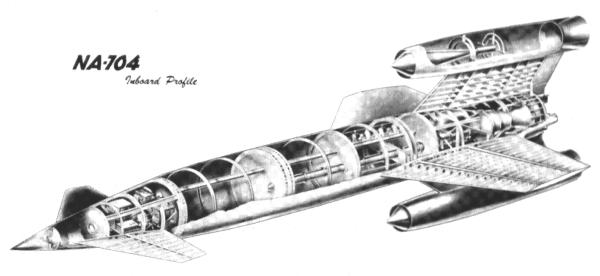 |
| Drawing: Dustin Carter collection |
| XSSM-A-2 |
The XSSM-A-2 design (North American Model NA-704) had an integral rocket booster and two fin-mounted ramjets for cruise propulsion. In late 1949 the first XSSM-A-2 missiles were under construction, but in 1950 the whole Navaho program was redefined to develop a missile of much longer range (8000 km (5000 miles)). In September 1950, it was decided that the development of the Navaho (designated Weapons System 104A) would become a three-phase effort. A turbojet-powered RTV-A-5 aerodynamic test vehicle would be followed by the SSM-A-4 Navaho II ramjet-powered test and evaluation (and possibly interim operational) model, and later by the ultimate SSM-A-6 Navaho III full-range operational missile. North American's XSSM-A-4 and XSSM-A-6 designs were better known by their manufacturer's numbers G-26 and G-38, respectively.
In 1951, the USAF assigned aircraft designations to its guided missiles, and the missiles of the Navaho family were redesignated as follows:
| Old Designation | New Designation |
|---|---|
| RTV-A-5 | X-10 |
| XSSM-A-4 | XB-64 |
| XSSM-A-6 | XB-64A |
The B-64 design used a large liquid-propellant rocket booster to launch a ramjet-powered cruise missile of canard/delta configuration. The test flights of the X-10 between 1953 and 1956 verified the basic aerodynamic design of the cruise stage, and in late 1956 testing of the G-26 was to begin. At that time, the XB-64 (G-26) and XB-64A (G-38) had been redesignated as XSM-64 and XSM-64A, respectively (and the missiles renamed to plain Navaho without suffix numeral). However, the XSM-64 suffered from a bewildering list of problems, and the first flight in November 1956 ended after only 26 seconds when the vehicle disintegrated because of longitudinal oscillations. The fifth flight of an XSM-64 in August 1957 was actually the first one to proceed until ignition of the cruise stage's ramjets.
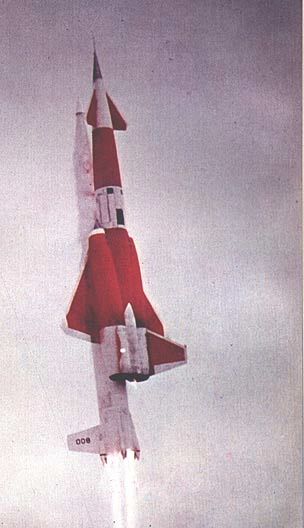 |
| Photo: USAF |
| XSM-64 |
The XSM-64 was launched from a pad by a large booster with an XLR71-NA-1 two-chamber liquid-fueled rocket engine. The booster accelerated the missile to almost Mach 3 at an altitude of more than 12000 m (40000 ft). Then the two Wright XRJ47-W-5 ramjets of the cruise vehicle ignited and the booster was dropped. Maximum cruising altitude of the XSM-64 was 24000 m (80000 ft), and it could reach a range of 5600 km (3500 miles) at a speed of Mach 2.75. The missile used a North American N-6 inertial navigation system for guidance, but was also equipped with a radio-command uplink and telemetry downlink for testing purposes. It also had a landing gear to reuse the missile after a successful flight, but not a single flight test ever proceeded as far as a landing attempt. The warhead section of the XSM-64 was designed to accomodate an early fission warhead (like the W-4 or XW-13), but after the invention of the thermonuclear bomb in the early 1950s, the XSM-64 was regarded as a pure test vehicle and no longer as an interim tactical missile.
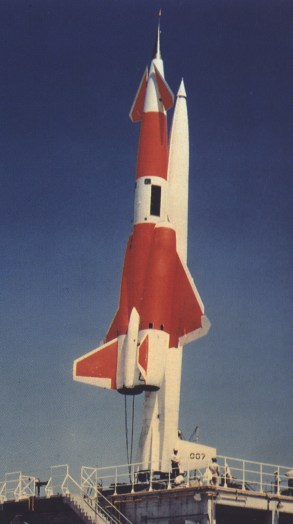 |
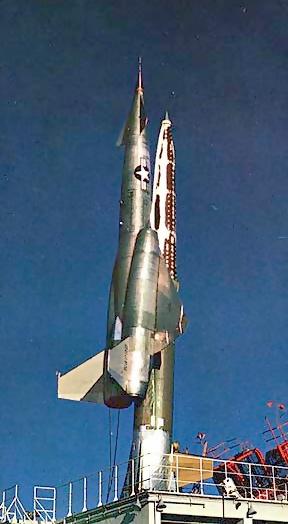 | |
| Photo: Rockwell International | Photo: USAF, via Tim Johnson | |
| XSM-64 | ||
The XSM-64 program was extremely troublesome, and after only four launches between November 1956 and June 1957, all ending in failure, the USAF cancelled the development of an operational SM-64 missile in July 1957. As an interim long-range strategic missile, the SM-62 Snark was far ahead in development, and in the longer term the SM-65/CGM-16 Atlas and SM-68/HGM-25 Titan ICBMs were much more promising. After the cancellation of Navaho, seven more flight tests occurred until November 1958 to use up some of the sixteen completed XSM-64 vehicles. None of these tests resulted in a 100% successful full-range flight.
The design of the ultimate XSM-64A missile (Model G-38) was completed by North American in February 1957, but the cancellation of Navaho meant that no XSM-64As were completed. The G-38 was basically an enlarged G-26 to accomodate a 4 MT W-39 thermonuclear warhead, and used improved RJ47-W-7 ramjets. The booster was also much larger and used a three-chamber XLR83-NA-1 engine, an improved development of the G-26's XLR71. Other differences between the XSM-64 and XSM-64A included the latter's changed wing and canard planforms and single vertical tail. The XSM-64A was to use an N-6B inertial navigation unit, and planned range was 10000 km (6300 miles) at a speed of Mach 3.25. G-38 test missiles would have been recoverable, using a landing gear consisting of nose wheels, a rear skid, and wingtip skids.
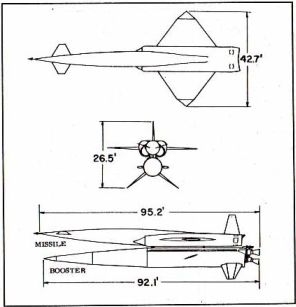 |
| Drawing: USAF, via Tim Johnson |
| XSM-64A |
Specifications
Note: Data given by several sources show slight variations. Figures given below may therefore be inaccurate!
Data for XSM-64, XSM-64A:
| XSM-64 | XSM-64A | |
|---|---|---|
| Length | Missile: 20.65 m (67 ft 9 in) Booster: 23.24 m (76 ft 3 in) |
Missile: 26.7 m (87 ft 7 in) Booster: 28.1 m (92 ft 1 in) |
| Wingspan | 8.71 m (28 ft 7 in) | 13.0 m (42 ft 8 in) |
| Height | 2.90 m (9 ft 6 in) | ? |
| Booster Diameter | 1.78 m (5 ft 10 in) | 2.4 m (7 ft 10 in) |
| Weight | Missile: 27200 kg (60000 lb) Booster: 34000 kg (75000 lb) |
Missile: 54600 kg (120500 lb) Booster: 81500 kg (180000 lb) |
| Speed | Mach 2.75 | Mach 3.25 |
| Ceiling | 24000 m (80000 ft) | > 24000 m (80000 ft) |
| Range | 5600 km (3500 miles) | 10000 km (6300 miles) |
| Propulsion | Missile: 2x Wright XRJ47-W-5 ramjet; 36 kN (8000 lb) each Booster: North American XLR71-NA-1 liquid-fueled rocket; 1070 kN (240000 lb) |
Missile: 2x Wright XRJ47-W-7 ramjet; 50 kN (11300 lb) each Booster: North American XLR83-NA-1 liquid-fueled rocket; 1800 kN (405000 lb) |
| Warhead | none | W-39 thermonuclear (4 MT) |
Main Sources
[1] James N. Gibson: "The Navaho Missile Project", Schiffer Publishing Ltd, 1996
[2] Bill Gunston: "The Illustrated Encyclopedia of Rockets and Missiles", Salamander Books Ltd, 1979
[3] Jay Miller: "The X-Planes, X-1 to X-45", Midland Publishing, 2001
[4] Tim Johnson: Space Launch Report Website
(originally at http://www76.pair.com/tjohnson/, now dead link (10 June 2005))
Back to Directory of U.S. Military Rockets and Missiles, Appendix 1
Last Updated: 1 December 2002